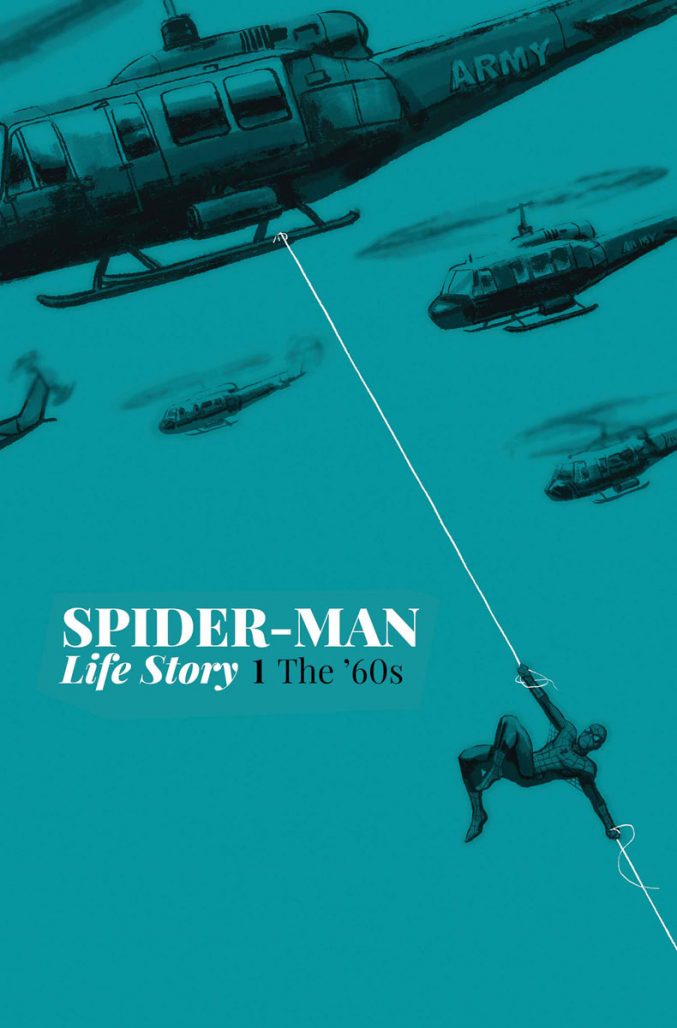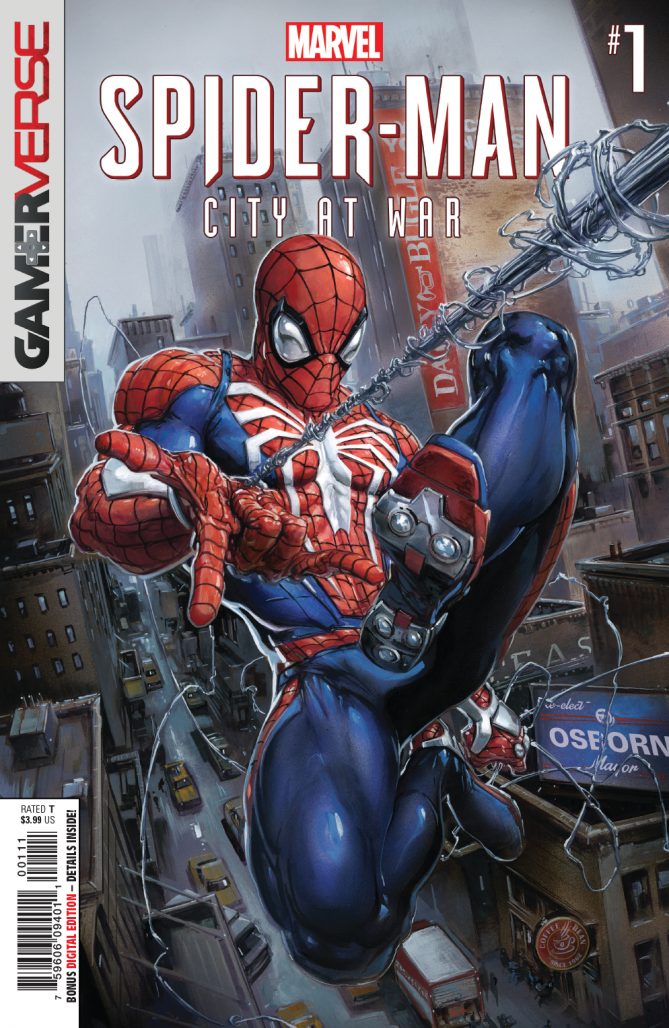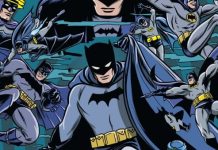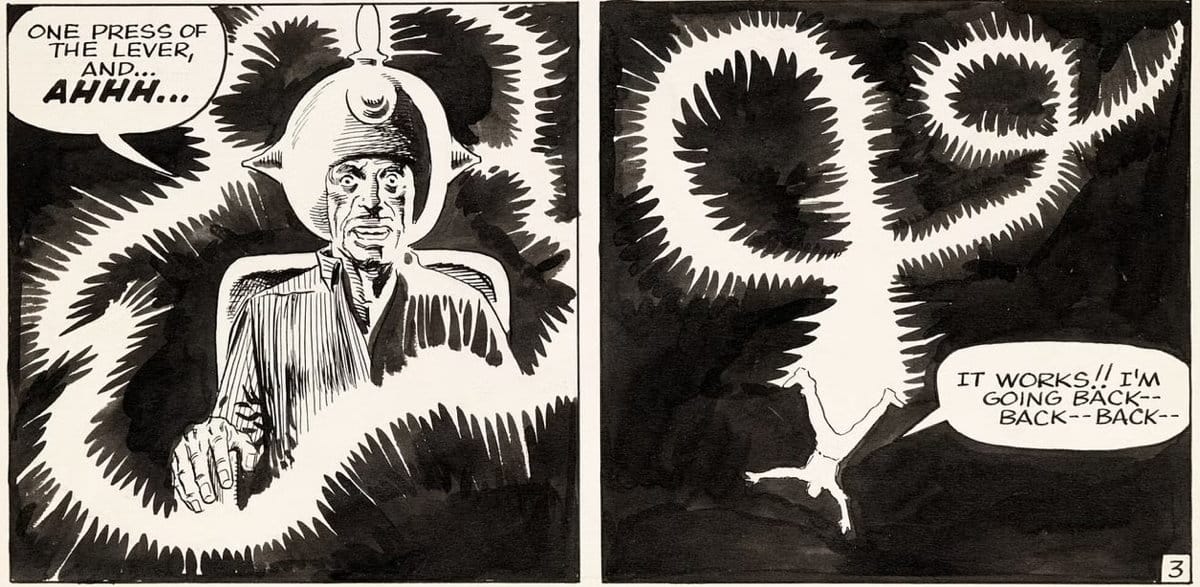What if superheroes aged in real time? What if Marvel’s flagship character, Peter Parker, the Spectacular Spider-Man, was 57 years old? This week Marvel answers that question with the debut of a new miniseries by Chip Zdarsky and Mark Bagley, Spider-Man: Life Story! Plus, spinning out of the hit video game, The PS4 version of Spidey gets his own miniseries with Marvel’s Spider-Man: City at War, and the new adventures of Carol Danvers continue in Captain Marvel #3. The Marvel Rundown is here!
 Spider-Man: Life Story #1
Spider-Man: Life Story #1
Written by Chip Zdarsky
Pencilled by Mark Bagley
Inked by John Dell
Colored by Frank D’Armata
Lettered by VC’s Travis Lanham
Cover by Chip Zdarsky
AJ Frost: Alexander, Samantha, welcome to another edition of Marvel Rundown. This week, we’re revisiting the early career of the one n’ only Spider-Man through the watchful eye of one Chip Zdarsky. What were your initial thoughts of Spider-Man: Life Story #1?
Alexander Jones: My emotions on the issue were all over the place. I’m a pretty huge Spidey fan and a mini telling his life story in real time is a really special idea. Author Chip Zdarsky executed the piece relatively well. I specifically want to point out the wild pacing of this story. I felt like some of the scenes in the issue crisscrossed and bumped into each other. The script had a really manic energy. I strongly dislike Mark Bagley’s pencils and was shocked to see just how polished they were in the issue. This was executed better than I could have possibly hoped for overall. What were everyone else’s thoughts?
Samantha Puc: I was really intrigued by the concept for Life Story and I’m genuinely impressed with the first issue. Tackling the Vietnam War from the jump is a bold move, but it’s one that Zdarsky handles with aplomb in his writing. I also loved the inclusion of Captain America and Iron Man and how their characters are used to discuss differing viewpoints on U.S. imperialism and what happened in Vietnam. I agree about the breakneck pacing, Alexander! It worked really well and established a unique rhythm for the story.
Frost: Looks like we’re on the same page in terms of this book being something special. For me personally, I really enjoyed the way Zdarsky played with internal Marvel chronology as well as having fun with the sandbox of history. The notions of intertwining Iron Man and Captain America (older, inherently more militaristic) with the campus idealism which Peter Parker inhabited created a lot of fun opportunities to compare and contrast ideologies, heroic identity, and, ultimately, purpose within the mythos. I wonder if y’all agree with this assessment, or think it’s off the mark.
Jones: I agree with everything you mentioned, AJ, and think Zdarsky dug deep into the setting of the issue! The script broke a ton of ground with Norman Osborn specifically here. I was surprised to see just how much plot and how many supporting cast members were jammed into the issue. This story has the really difficult task of exploring one of (if not the) most recognizable origin stories in all of modern American comic books. I think Zdarsky threw in just enough plot and characterization here to keep things fresh. I also really hope that all future issues will take even more license to push the premise as far as it can go. Readers don’t want another Spider-Man origin, they want a Zdarsky and Bagley mini-series about a superhero growing up in The Marvel Universe.
Puc: I agree with the above as well. My understanding of this series is that each issue will dig into major events from the decade represented, which I hope is true. There’s so much potential for where this series can go and I know there are a few historical events that I really hope are explored, especially with this creative team holding the reins. I think we’ve seen a lot of less-than-unique takes on the ‘Peter Parker as Spider-Man’ origin story, but this feels really fresh, which excites me.
Frost: Alex, you mentioned before that you dislike Bagley’s pencils. What happened here in this presentation of Spider-Man that made you change your mind? And Sam, what were your thoughts on the art found in this issue?
Puc: I liked the bold lines and felt like the style worked especially well for the era. Bagley and inker John Dell established a solid aesthetic with some fantastic use of perspective that not only captured the wild pacing of the story but encapsulated so much of the upheaval of the ’60s. Frank D’Armata’s colors were also great — I felt immersed in this world in a big way.
Jones: I actually do not like Frank D’Armata’s colors. They wash away some of the detail in the artwork and do not serve the story. The science scenes with Gwen Stacy lend the color palette a neutral tone that sucks the emotion out of the scene. While I think the issue does a good job lending a sense of slick detail in the issue, scenes like this that have minimalist detail detract from my enjoyment of the art. I think Dell could have possibly added to Bagley’s line as well to make the issue have a cleaner aesthetic overall. The art in this issue is really solid and beautiful at points, I just don’t think it is perfect. I’m really happy to see the representation of Bagley’s pencils that are more slick and refined showing that he is a really talented Marvel artist who may just be rushing certain issues to get them finished as soon as possible.
Frost: What, in your opinions, could have made this issue stronger? And, maybe as a meta-question: Why do we need another retelling of Spider-Man’s life? At this point, it seems to have moved passed cliché and is part of the cultural ether. Is Marvel obsessing now with “grand design” retellings of their most popular properties to entice new fans? What do experienced fans have to gain from reading this book, you think?
Jones: My specific point of contention re: D’Armata’s colors is how the color palette looks dull in some scenes. Bagley is bringing his A-game here and the washed out bright hues do not support the quality of the line art in my not-so-humble-opinion. Also, I get where you are coming from with Parker’s origin. We have seen it before. This issue treads on that territory a little too close for comfort.
Puc: I wanted this issue to lean a little bit harder into why Steve was questioning the validity of the U.S. invading Vietnam and have Peter reflect on that as well. As far as this adding to the pile of retellings, I think this is a series that will create dialogue for fans old and new about the events that it explores, not just from the perspective of “how would Spider-Man have handled this?” but from the perspective of “we need to remember our history as we continue to make the same bad choices.” I’m always a fan of works that seek to explore real-life issues with real-life consequences through the lens of familiar characters and concepts.
Jones: In my opinion, this is an okay way to kick off the mini-series but I hope future issues will spin away from the continuity and allow Zdarsky to create truly new Spider-Man scenarios. Samantha’s analysis of the cliffhanger could be the start of what I want to see going forward. Some of the developments here with Gwen were also pretty interesting and will hopefully take the writing in a different direction from previously established Marvel continuity as well. What are your thoughts on my critical assessment of the art, AJ?
Frost: As you know, Alex, my thoughts on Marvel art of late have pretty much ranged from ‘meh’ to ‘negative,’ but I was actually really delighted with the art here. Bagley has a way of conveying so much emotion clearly and distinctly. I thought the coloring was good, the lines crisp, and the action nice and flowing. I agree with both of you about the story beats. And it’ll be interesting to see where Zdarsky takes Spider-Man through the challenges of the ensuing decades. What are everyone’s final thoughts on this issue?
Puc: Overall, I think this issue is really interesting and really solid as a #1. That said, I personally plan to wait for the entire series to be released in a TPB before grabbing it at my LCS. My verdict on this is a tentative BUY.
Jones: I agree. I think we are right on the edge of a BUY here. I think there’s just enough stuff for people who like Spider-Man to check this one out. I know there are lots of Marvel fans who love mini-series like this that will likely get a kick out of this revised continuity story. That being said, if you are tired of Spider-Man’s origin and retro-pastiche, this likely isn’t going to be a cure. I also want the creative team to push this premise farther in future issues so we can see some Spider-Man ideas that are wholly original.
Frost: This is a BUY from me as well. Zdarsky’s take on Spidey hits all the right notes and creates a lot of interesting potential for the future of the run. This should not be missed!
Final Verdict: AJ, Samantha, and Alexander say BUY!
 Marvel’s Spider-Man: City at War #1
Marvel’s Spider-Man: City at War #1
Written by Dennis “Hopeless” Hallum
Story by Jon Paquette, Bryan Intihar, Insomniac Games Writing Team
Illustrated by Michele Bandini
Colored by David Curiel
Lettered by VC’s Travis Lanham
Cover by Clayton Crain
Reviewed by Alexander Jones
Marvel’s Spider-Man City at War #1 is the debut of Marvel’s GamerVerse. Despite a ridiculous name and eye-rolling concept that the issue is based on a video game story, writer Dennis “Hopeless” Hallum pens a script that manages to define what made the narrative of the game so impossibly endearing. Getting to know this alternate version of Peter Parker who is just a bit different from the conventional comic book counterpart proved endearing throughout the video game’s campaign. It is fascinating to see Hallum really switch up the medium and form of comic books in his approach to the script. Instead of crafting longer traditional scenes, Hallum breaks up the flow of the action and utilizes the story to create scenes that serve as vignettes. Getting to see the conflict between Peter and Dr. Octopus develop alongside several other villains in the course of one issue is something Stan Lee and Steve Ditko first introduced in the comic books. Peter didn’t have to worry about one specific villain because there are several baddies to worry about at any given moment. Watching Peter wander through some of his personal interactions in his daily life gives the issue a grounded sensibility.
While the issue is an impressive outlet for the Playstation hero, it can be slightly disheartening to consider that this is an adaptation of the video game. Readers interested enough in the property are likely to pick this book up hoping for something fresh and new. The way Hallum’s script stitches all the elements together is fascinating and the revised dialogue is impressive. Even some of the scene transitions from one moment to the next are really interesting. I hope someone at The Big Two will take notice of how this story is constructed and take on a similar approach to other series. The issue switches between scenes every three pages and creates a dizzying, enchanting rhythm that will get the attention of the reader right away.
Michele Bandini captures a few incredible moments with Spider-Man. David Curiel’s colors are excellent throughout the issue. The one flaw in the artwork comes with some of the more muted facial expressions on the characters. Bandini’s rendition of Spider-Man is a lot more lifelike than the depiction of the simply-drawn Peter Parker. The backgrounds in the issue can also be sparse. Bandini does a great job capturing the comedic moments with some of the timing and acting in the pencils. Some of the scenes with the characters in fluid motion look fantastic and come off as some of the most inspired visual sequences in the issue. It also seems like Bandini has an easier time drawing supernatural elements or masks as opposed to humans.
Final Verdict: If you haven’t played the PS4 game, Marvel’s Spider-Man City at War #1 is an easy BUY. If you have already played the game, the comic book doesn’t qualify as essential, but still merits a BROWSE!
 Captain Marvel #3
Captain Marvel #3
Written by Kelly Thompson
Illustrated by Carmen Carnero
Colored by Tamra Bonvillain
Lettered by VC’s Clayton Cowles
Cover by Amanda Conner & Paul Mounts
Reviewed by Samantha Puc
In case you aren’t already in love with Carol Danvers after seeing Brie Larson in Captain Marvel, the character’s current ongoing series from writer Kelly Thompson, artist Carmen Carnero, colorist Tamra Bonvillain and letterer Clayton Cowles may tip you over the edge.
From the jump, this series has provided a starting point for new fans and a fresh new story of Carol’s life for die-hard members of the Carol Corps. It’s a vibrant, complex story with tons of incredible characters, including Jessica Drew (Spider-Woman), Jennifer Takeda (Hazmat) and Maya Lopez (Echo). The basic plot? The misogynist Nuclear Man has trapped Carol and her friends on a post-apocalyptic version of Roosevelt Island, where some of their powers don’t work and his creepy robots keep referring to them as ‘wives’. One man, Som, is seemingly on their side, but he isn’t quite who he seems, as he reveals in Captain Marvel #3.
This issue is fast-paced enough to make the reader’s heart pound. It picks up right where issue #2 left off, with Jennifer Walters (She-Hulk) falling through the barrier Nuclear Man has set up and de-hulking halfway to the ground… which means she’ll die if she actually lands in her human form. Once she’s secured, more battle ensues, before loyalties are tested and Carol goes on a dangerous fact-finding mission into Nuclear Man’s Misogyny Island headquarters. What she finds is so unexpected that this reviewer actually gasped out loud. (I cannot wait for issue #4.)
Thompson’s dialogue in this issue is stellar as usual, but even better is the way she writes Carol’s internal monologue as she fights to organize her troops, train civilian women and save them all. Carmen Carnero’s art is bold, brash and beautifully executed, especially with Bonvillain’s vibrant and exacting color work. Cowles’ lettering is also great and stands out only when it’s meant to, otherwise blending into the story so that it’s easy to follow and well-rendered.
We also see a new character design for Carol in this issue, which comes about slowly as she and her friends create a plan to save themselves and the other women from Nuclear Man’s gross plot. By the time the issue ends, she’s apocalypse-hardened and hot as hell; but rather than losing clothes, she gains more armor and a much tougher look that suits her, especially in this environment.
Final verdict: BUY. This Captain Marvel run is ideal for anyone and issue #3 introduced some truly shocking points of conflict while also building genuine character connections and plot points that will surely be explored more fully as the series continues. It’s a must-read.
Next week, we catch up with Spider-Man’s “Hunted” crossover!



 Spider-Man: Life Story #1
Spider-Man: Life Story #1
 Marvel’s Spider-Man: City at War #1
Marvel’s Spider-Man: City at War #1
 Captain Marvel #3
Captain Marvel #3







Nice to see that Carol will oppose any oppressive regime that she’s not a part of. I do think the art is good.
Comments are closed.